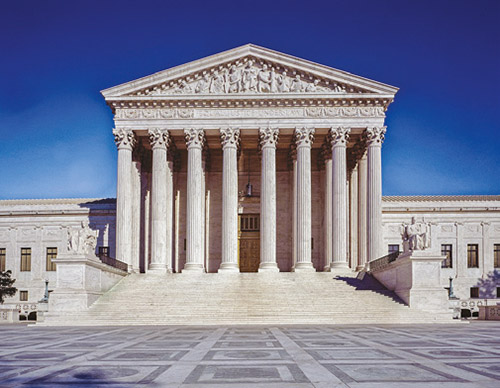


While much of the press coverage of the Supreme Court in recent weeks has focused on a case that targets abortion rights, another case under consideration now may result in profound changes to whether or not, when and how government can provide support to activities in religious institutions.
In a virtual briefing held by the Orthodox Union’s Advocacy Center and the Teach Coalition on December 8, conducted over Zoom and attended by over 300 people, two expert observers of the Supreme Court sketched out the stakes in the Justices’ consideration this term of the Carson V. Makin case. In that case, the state of Maine is being challenged by a group of parents for its decision to deny funding to “sectarian” schools, in a tuition assistance program that assists families in districts where public secondary schools are not available.
In the briefing, which featured Nathan Diament, executive director of the OU Advocacy Center; Professor Avi Helfand, vice dean of the Pepperdine Law School and visiting professor at Yale Law School; and moderator Daniel Mitzner, COO of the Teach Coalition; the speakers illustrated the ramifications of some possible decisions in the Carson V. Makin case. They include whether or not the funding for pre-K classes in the pending federal ‘Build Back Better’ bill could be denied to nonpublic schools that offer some form of religious instruction as part of the curricula; the standing of security grant programs, on the federal and state level, that assist religious institutions; federal and state support for COVID-19 vaccination programs that are held on the premises of religious schools or houses of worship; and New York State funding for STEM teaching programs in nonpublic schools.
Professor Helfand stated that up until the 1970s, the Supreme Court’s answer to the question “When can the government fund activities in religious institutions?” was largely “Never.” But starting with a case in the 1980s, the Supreme Court established that religious institutions could not be excluded from government funded programs solely because of their status as religious institutions. Yet subsequent cases allowed exclusions for situations when the ‘use’ of government funding might serve a religious purpose.
As Helfand and Diament argued in the briefing, and in a recent op-ed published in The Wall Street Journal (December 2), the distinction between ‘status’ and ‘use’ in denying government funding is very permeable and often discriminatory. They pointed out that Jewish religious schools are particularly vulnerable to the ‘use’ exclusion, because the curriculum in these schools is integrated to reflect religious values and areas where the government has a clear imperative (such as in furthering strong STEM education) are informed by Jewish teachings.
Diament stated that a Supreme Court ruling in the Carson v. Makin case that expanded the legal framework for government support of societal needs being addressed within religious frameworks would enable expanded advocacy by groups like the OU Advocacy Center and the Teach Coalition.
Helfand shared that they envision four possible outcomes in this case: The Supreme Court may expand religious institutions’ access to government funding; The Supreme Court may simply preserve the status quo; The Supreme Court may create a carefully carved distinction to allow funding in some situations and not others; or The Supreme Court may offer a particularly nuanced decision that makes it harder to draw clear distinctions.
The Orthodox Union Advocacy Center submitted a ‘friend of the court’ brief to the Supreme Court for this case, joining many other groups on both sides of the issue. Diament and Helfand noted that the Supreme Court heard arguments in this case that morning and Justices Kavanaugh, Gorsuch, Thomas, and Alito spoke up and seemed skeptical of the Attorney General of Maine’s presentation, while Justice Breyer appeared most concerned about preserving church/state separation.
Diament and Helfand explained that the Supreme Court may issue its decision in this case any time within the next few months and shared that historically, the Supreme Court has held on to some high-profile cases and issued their decisions only at the end of their term of decision-making, in mid-June.
Diament and Mitzner stated, at the end of the briefing, that this Supreme Court case illustrates vividly the importance of communal advocacy and promised to keep community members ‘in the loop’ when there are updates in the case.
By Harry Glazer









